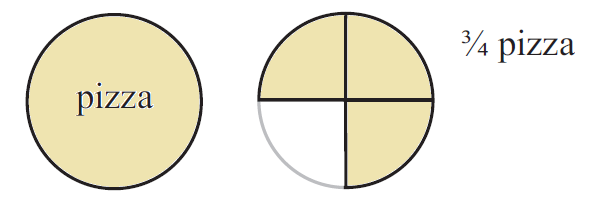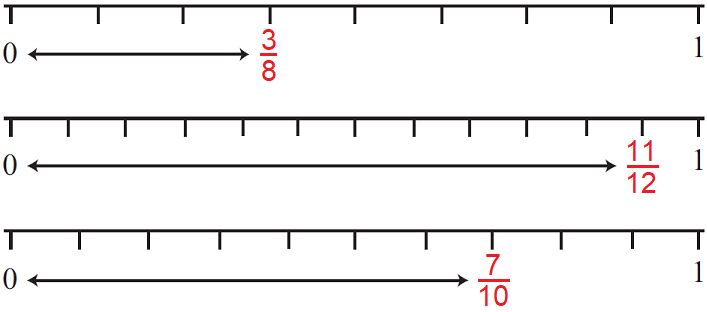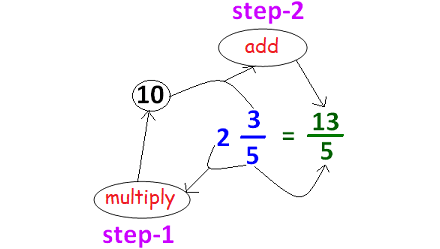CONCEPT OF FRACTION
Introduction to Fraction
What is a fraction?
Fraction is the way in which we are writing parts of a whole number. For example if we take a pizza, and divide it up equally between 4 people, each person will have 1/4 or, written in words, one quarter of the pizza.

If a person takes 2 quarters of a pizza, then he would have 2/4, which is the same as 1/2 or half the pizza.
2/4 = 1/2

If a person takes 3 quarters of a pizza, then he would have 3/4.
3/4 of a pizza or three quarters has gone and 1/4 or one quarter remains.

Finally, the whole pizza is 4/4, or four quarters.
Some chocolate bars can conveniently be marked to make them easier to break into pieces to eat. For instance, you can have a bar marked into 6 equal pieces, so each piece is 1/6, or one sixth of the whole bar. So if you share this bar between 6 people, each person gets 1 piece each.

If you share it between just 2 people, each person could have half the bar each, which would be 3 pieces each.
3/6 = 1/2

Similarly, if you share it between 3 people, each person gets 1/3 of the bar each, which is 2 pieces.
1/3 = 2/6

We are getting exactly the same result each time, but in different ways. We can also think of its meaning in more than one way.
or as
1/3 = 1 ÷ 3 = 1 whole bar of chocolate divided into 3 pieces
If you take all 6 pieces, you would have 6/6 which is the whole bar.
6/6 = 1
just as 6 ÷ 6 = 1.
You can divide a whole number into any number of pieces of equal size, and then you can take any number of those pieces, for example 3 8 is a whole divided into 8 pieces, and you have taken 3 of them. Similarly
13/15 means 13 pieces out of 15
7/8 means 7 pieces out of 8
100/600 means 100 pieces out of 600
5/167 means 5 pieces out of 167
Fractions can also be represented on a section of a number line. You can take the section from 0 to 1, and divide it up into the total number of pieces. Then you count off the number of pieces you have taken.

Fractions are formed by splitting a whole into any number of pieces of equal size.
Equivalent Fractions
Let us examine more closely what fractions look like.
Take 1/2 and you can see that the bottom number is twice the size of the top number, so any fraction where the bottom number is twice the top number is equivalent (the same as) a half. So
are all equivalent fractions that mean 1/2.
When a half is written as 1 over 2 rather than 2 over 4, or 5 over 10, or any other version, it is said to be in its lowest term or simplest form. This is because no number, except 1, will divide into both the top number and the bottom number. So to put a fraction in its lowest form, you divide by any factors common to both the top number and the bottom number.
Equivalent fractions can be found for any fraction by multiplying the top number and the bottom number by the same number. For example, if you have 3/4, then multiplying by 2 gives
or by 3 gives
Multiplying by 10 gives
and all of these fractions are exactly the same as 3/4.
When dealing with fractions, we often use some special mathematical language. Instead of using the words 'top number' and 'bottom number' we use the words numerator and denominator. So, in 3/4, 3 is the numerator and 4 is the denominator.
Example 1 :
Write the following fraction in its simplest form.
4/200
Solution :
Here, we are going backwards. From a fraction in its lowest form, we must have multiplied both the numerator and the denominator by the same number to obtain this equivalent fraction 4/200.
So now we have to divide divide both the numerator and the denominator by the same number. We know that both 4 and 200 are even number, hence they are evenly divisible by 2. So, let us divide both numbers by 2, giving 2/100.
Again both 4 and 50 are even numbers and they are evenly divisible by 2. Dividing both 2 and 100 by 2 gives 1/50.
Now, there is no common divisor for 1 and 50 other than 1. So, the fraction 1/50 in its simplest form.
Since we have divided by 2 twice here, we could have just divided by 4 originally. But we can’t always spot the highest common factor of the two numbers straight away.
Different Types of Fractions
It doesn’t matter how many equal pieces a whole is split into, if all the pieces are then taken, we have the whole again. For example,
5/5 = 3/3 = 8/8 = 1
just as 5 ÷ 5 = 1, 3 ÷ 3 = 1, 8 ÷ 8 = 1 and so on.
We have some more mathematical names to describe some fractions. If the numerator is smaller than the denominator, the value of the fraction is less than 1 and it is called a proper fraction.
For example
1/2, 3/4, 1/6, 7/8, 5/10, 11/13
If the numerator is larger than the denominator and hence the value of the fraction is greater than 1, then it is called an improper fraction.
For example
3/2, 7/5, 11/6, 17/8, 27/10, 13/11
Here, 3/2 means 3 lots of a half, 7/5 means 7 lots of one fifth and so on.
Improper fractions arise where more than one whole has been split up, and they can also be written as a mixture of whole numbers and fractions.
For example, if we have 3/2, then we can think of this as 4/4 plus another 1/4, and the 2/2 form the whole.
5/4 can be written as 1¼
Similarly with, say, 8/3. Every 3 slots of 1/3 makes a whole one, so we have 2 whole ones and 3 left over.
In other words, we calculate 8 ÷ 3, 3 goes into 8 twice and the remainder is 2.
8/3 = 2⅔
Some more examples :
7/4 = 1¾
13/5 = 2⅗
These are referred to as mixed fractions or mixed numbers.
Now let us look at turning mixed fractions into improper fractions. Suppose we start with 2⅗.
To convert from mixed fractions to improper fractions you multiply the whole number by the denominator then add the numerator before writing it all over the denominator.

We can even write any whole number as a fraction, in many different ways.
For instance,
2 = 2/1 = 4/2 = 30/15
Fractions may appear as proper fractions, improper fractions or mixed fractions. They may also appear in many equivalent forms.
Kindly mail your feedback to v4formath@gmail.com
We always appreciate your feedback.
©All rights reserved. onlinemath4all.com
Recent Articles
-
Trigonometry Reciprocal Identities
Apr 28, 24 10:10 AM
Trigonometry Reciprocal Identities -
IB Diploma Mathematics Problems on Exponents
Apr 28, 24 05:42 AM
IB Diploma Mathematics - Problems on Exponents -
Finding Vertex of a Quadratic Function Worksheet
Apr 27, 24 11:06 AM
Finding Vertex of a Quadratic Function Worksheet
